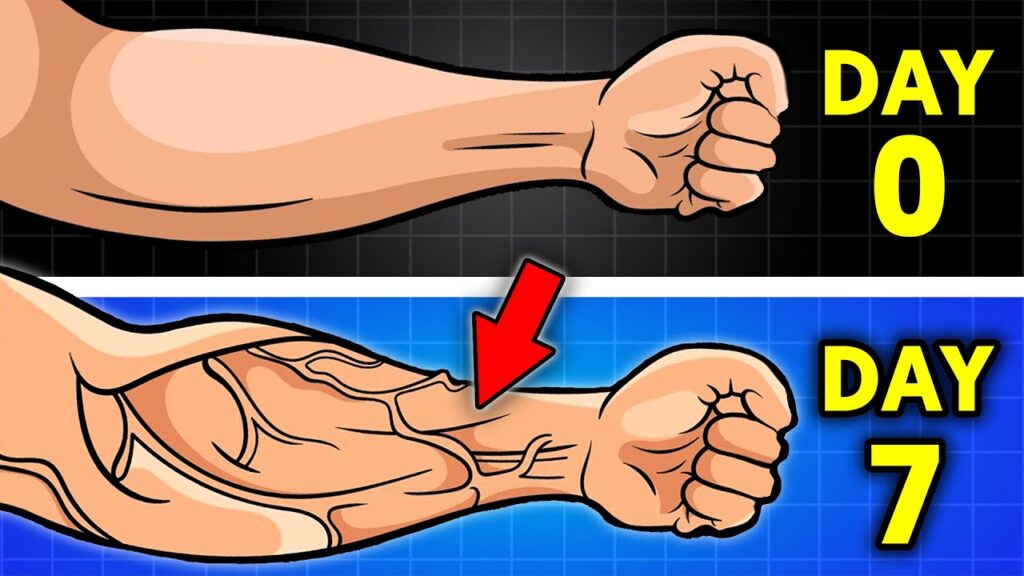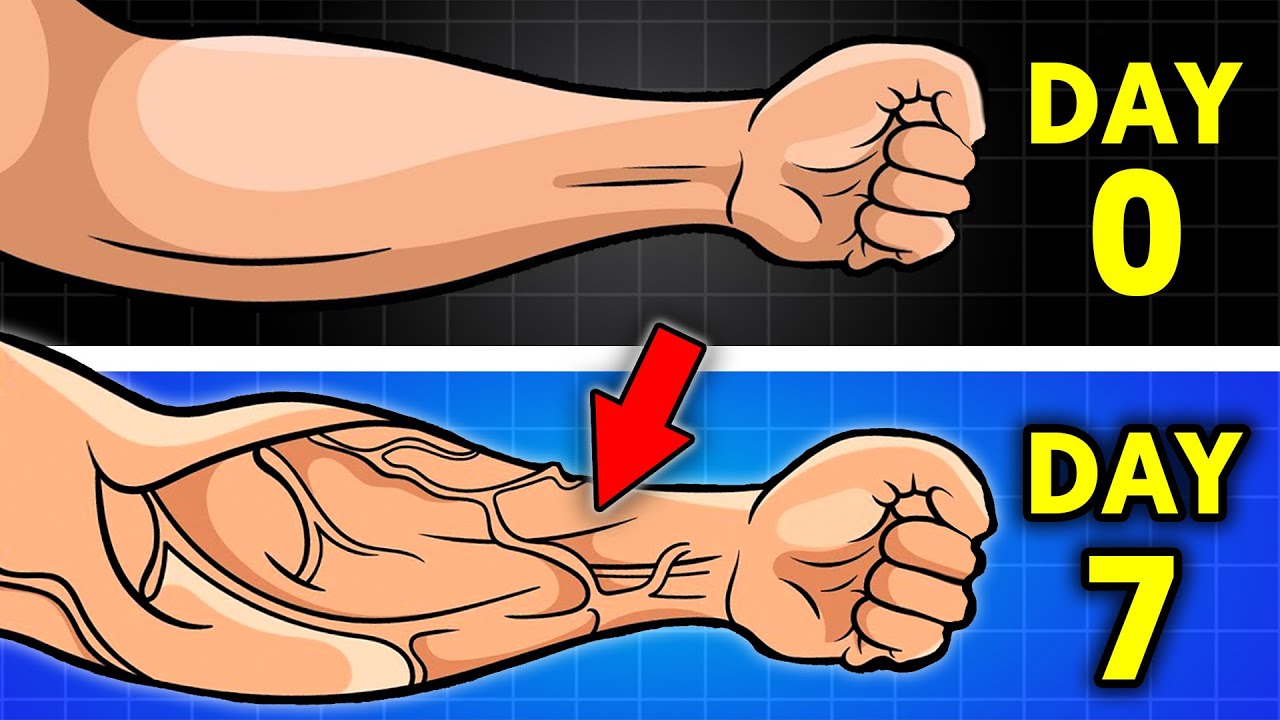Introducing “10 Habits to Develop Veiny Arms” by Body Hub, a video that explores the key habits necessary for achieving vascular arms. Veiny arms are often associated with a shredded physique, commonly seen in bodybuilders and athletes. While genetics may play a role, anyone can improve their vascularity through specific changes. The video promises to reveal a secret weapon for achieving vascular arms, including habits such as losing body fat gradually, gaining more muscle, using specific training techniques, flexing the forearms, staying hydrated, doing forearm and grip-focused exercises, making diet tweaks, considering supplements, hanging the arms down, doing steady cardio, and foam rolling before and after workouts. These habits are all aimed at improving blood flow, increasing muscle definition, and enhancing vascularity in the arms. Stay tuned until the end to discover the secret weapon for achieving those veiny arms!

Gradually Lose Body Fat
One of the key habits for achieving veiny arms is to gradually lose body fat. Body fat is the primary factor in achieving a vascular appearance, as excess fat can hide the outline of the veins. So, the leaner you are, the more noticeable your veins will be. To lose body fat, it is essential to create a calorie deficit through a combination of diet and exercise.
When aiming to lose body fat, it is crucial to do so gradually to avoid losing muscle mass. Rapid weight loss can often result in muscle loss. It is recommended to aim for a gradual weight loss of 0.5 to 1 pound per week. This can be achieved by reducing your daily calorie intake by 200-300 calories in the first week and monitoring your progress. If weight loss is within the acceptable range, continue with the same calorie intake for another week. If progress plateaus or weight loss is not occurring, further reduce your calorie intake by another 200-300 calories and repeat this process weekly.
By gradually losing body fat, you can lower your overall body fat percentage, making your veins more visible and giving you the vascular appearance you desire.
Gain More Muscle
Another important habit for achieving veiny arms is to gain more muscle. Having more muscle mass in your arms increases vascularity and makes the veins more prominent. Building muscle can be achieved through resistance training and weightlifting exercises.
During a fat loss phase, where the goal is to lose body fat, it is crucial to lift heavy weights to maintain muscle mass. Lifting heavier loads for 5-10 reps throughout the fat loss phase can help preserve muscle mass. It is recommended to include both heavy and light weights in your training program to stimulate muscle growth and retention.
Higher volume training with lighter weights, such as sets of 10-15 or 15-25 reps, can be an effective way to preserve muscle mass while dieting. This approach increases training volume, which promotes muscle growth and retention. It is important to prioritize weight training over cardio during a fat loss phase to maintain muscle mass and achieve a more vascular appearance.
By gaining more muscle mass, you can enhance vascularity and achieve a more shredded and vascular look in your arms.
Use Specific Training Techniques
Incorporating specific training techniques into your workouts can help increase blood flow to the muscles and promote vascularity. Two effective techniques for enhancing blood flow and vascularity are pump sets and blood flow restriction training (BFR).
Pump sets involve performing sets with higher reps and shorter rest periods. This increases blood flow and circulation to the muscles, causing the veins to become more prominent. By incorporating pump sets into your workouts, you can stimulate muscle growth and increase vascularity.
Blood flow restriction training (BFR) is a technique that involves temporarily restricting blood flow to the muscles during sets. This technique has been shown to increase muscle growth, muscle pumps, and vascularity. By using specialized bands or cuffs, you can restrict blood flow to the working muscles, which leads to increased metabolic stress and muscle hypertrophy.
By incorporating these specific training techniques into your workouts, you can enhance blood flow to the muscles and achieve a more vascular appearance in your arms.
Flex the Forearms
Flexing the forearms and performing forearm exercises can make the veins in your arms more pronounced. By actively squeezing and flexing your forearms, you encourage blood flow to the area, resulting in more visible veins. This can be done by laying your hands palm side up on a flat surface and gripping your hands into fists, then releasing and repeating this pumping action.
Additionally, using stress balls or grip clamps can provide resistance and further engage the muscles in your forearms. Performing this forearm flexing technique during your strength training workouts can help achieve that pumped and veiny look.
Including forearm exercises, such as wrist curls, reverse curls, and hammer curls, in your workout routine can also help increase muscle mass in the forearms, making the veins more prominent.
By flexing the forearms and incorporating forearm exercises into your workout routine, you can enhance the visibility of the veins in your arms.
Stay Hydrated
Staying hydrated is not only essential for overall health and performance but also plays a role in vascularity. Adequate hydration improves blood flow and muscle pumps, making your veins more visible.
When you are dehydrated, blood circulation can become restricted, resulting in less noticeable veins. Drinking enough water throughout the day helps maintain proper blood volume and circulation, enhancing vascularity. The general recommendation for water intake is to drink between three-quarters and one gallon of water per day for adult men and women.
If you engage in regular exercise or intense physical activity, your water needs may increase. Sweating during exercise can result in fluid loss, so it is important to replenish your body with water to maintain hydration levels.
By staying hydrated, you can improve blood flow, muscle pumps, and overall vascularity in your arms.
Do Forearm and Grip-Focused Exercises
In addition to flexing the forearms, incorporating forearm and grip-focused exercises into your workout routine can help increase lean muscle mass in the arms.
Exercises such as wrist curls, reverse curls, and hammer curls target the muscles in the forearms and can contribute to increased vascularity. These exercises can be performed using dumbbells, barbells, or resistance bands.
Working on grip strength, such as using grip trainers or performing exercises like dead hangs, can also engage the muscles in the forearms and increase vascularity. Hanging from a bar or door frame for a period of time can help build forearm strength and improve blood flow to the area.
By including forearm and grip-focused exercises in your workout routine, you can increase lean muscle mass in the arms and enhance vascularity.
Make Diet Tweaks
Making diet tweaks can also contribute to reducing body fat and water retention, which can enhance vascularity in the arms.
One important tweak is to increase your intake of lean protein. Consuming lean protein sources such as chicken, fish, eggs, and low-fat dairy can support muscle growth and development. Protein is essential for building and maintaining lean muscle mass, which can help make your veins more visible.
Another tweak is to reduce your sodium intake. High sodium levels in your diet can lead to water retention, which can obscure muscle definition and make it harder for your veins to be visible. Cutting back on processed and high-sodium foods and incorporating more whole, unprocessed foods into your diet can help reduce water retention and enhance vascularity.
Additionally, incorporating slow-digesting carbohydrates, such as brown rice, sweet potatoes, and whole grains, can help regulate blood sugar levels and reduce water retention. These carbohydrates are also beneficial for providing sustained energy during workouts.
By making these diet tweaks, including increasing lean protein intake and reducing sodium intake, you can reduce body fat and water retention, leading to enhanced vascularity in the arms.
Consider Taking Supplements
In addition to proper nutrition, certain supplements can help improve blood flow and vascularity. Two supplements that are often used to enhance vascularity are nitric oxide and L-Arginine.
Nitric oxide (NO) is a vasodilator, meaning it relaxes and widens blood vessels, allowing for increased blood flow. Research has shown that NO supplementation can improve blood flow and performance in healthy adults and athletes.
L-Arginine is an amino acid that is converted into nitric oxide in the body. By taking L-Arginine supplements, you can increase nitric oxide levels, which can lead to improved blood flow and vascularity.
Before incorporating any supplements into your routine, it is always best to consult with a healthcare professional or registered dietitian to ensure they are safe and suitable for you.
By considering the use of supplements such as nitric oxide and L-Arginine, you can enhance blood flow and vascularity in the arms.
Hang the Arms Down
A simple habit that can improve blood flow to the extremities and enhance vascularity is to let your arms hang down. When your arms are hanging down, gravity assists in improving blood flow to the hands and arms, making the veins more visible.
The practice of hanging the arms down can be done throughout the day, whether you are standing, sitting, or even lying down. Allowing your arms to hang down for a few minutes at a time can help increase blood flow and promote vascularity in the arms.
By incorporating this habit into your daily routine, you can improve blood flow and enhance the visibility of veins in your arms.
Foam Roll Before and After Workouts
Foam rolling, also known as self-myofascial release, is a technique that involves applying pressure to specific areas of the muscles using a foam roller. Foam rolling before and after workouts can have several benefits, including enhancing circulation and blood vessel dilation.
Foam rolling helps improve circulation by massaging and releasing tension in the muscles and connective tissue. By applying pressure to specific areas, you can stimulate blood flow to the muscles, making them more receptive to nutrients and oxygen.
Additionally, foam rolling promotes blood vessel dilation, which allows for increased blood flow and improved vascularity. By foam rolling before and after workouts, you can enhance circulation and help make your veins more pronounced.
Incorporating foam rolling into your warm-up and cool-down routines can be an effective habit for improving blood flow and vascularity in the arms.
In conclusion, achieving veiny arms requires a combination of various habits and lifestyle changes. Gradually losing body fat, gaining more muscle, using specific training techniques, flexing the forearms, staying hydrated, doing forearm and grip-focused exercises, making diet tweaks, considering taking supplements, hanging the arms down, and foam rolling before and after workouts are all key habits that can contribute to increased vascularity in the arms. By incorporating these habits into your routine and remaining consistent, you can achieve the veiny arms you desire. Remember to consult with a healthcare professional or fitness expert before making any significant changes to your diet or exercise routine.
